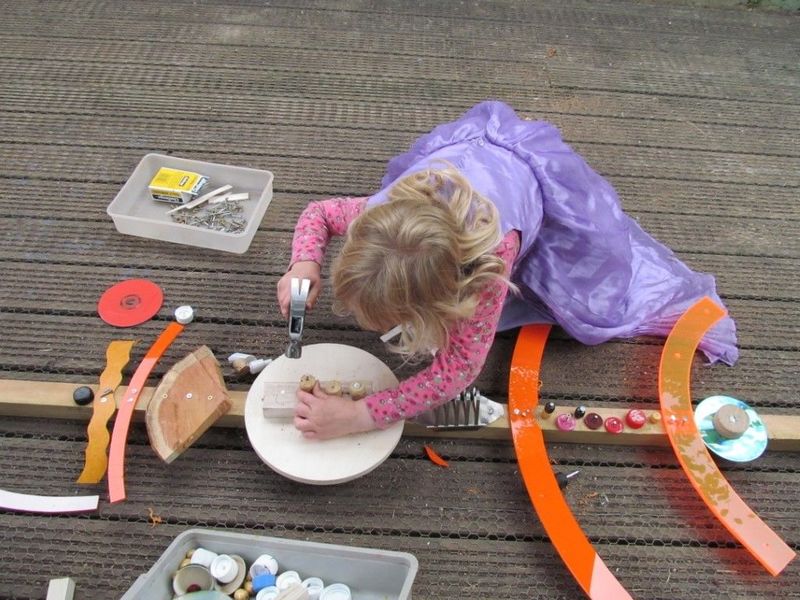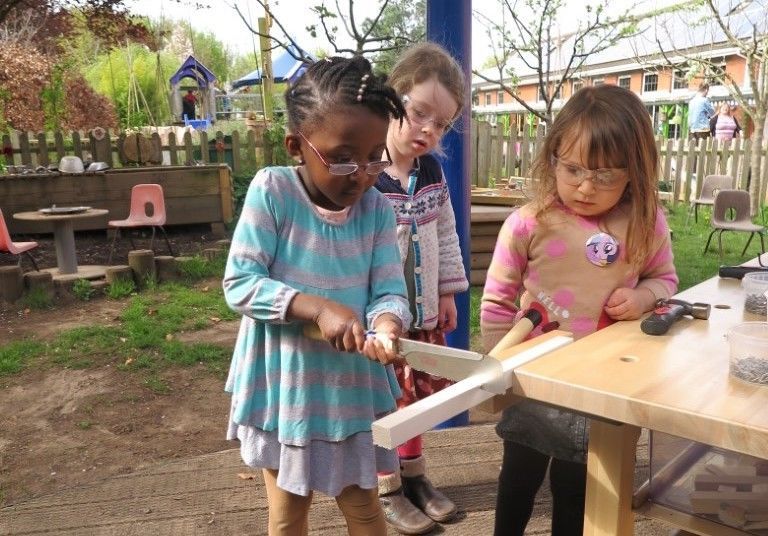‘As children make with wood they are learning skills that will empower them to shape their world’
Many are surprised by the idea of young children working with real tools but woodwork actually has a long heritage in early childhood education going right back to the days of Froebel’s Kindergarten. In recent decades it almost disappeared but it is now making a comeback, with renewed interest from all around the world. A noisy revolution is taking place!
The Big Bang Project is at the forefront of this, by providing lots of free resources to teachers around the world as well as delivering training and researching the impact of woodwork on children’s learning and development.
There is something really special about woodwork. It is so different from other activities. The smell and feel of wood, using real tools, working with a natural material, the sounds of hammering and sawing, hands and minds working together to express their imagination and to solve problems, the use of strength and coordination: all combine to captivate young children’s interest. It provides a truly unique experience.
But what about the safety I can hear you say! Woodwork is actually a low-risk activity as long as some basic safety measures are put in place and appropriate tools are used. Children’s behavior is exemplary at the woodwork bench – they are engaged and doing something they enjoy. It is also important that children get to experience risk and challenge within a controlled environment so they learn to make decisions and judgments to protect themselves. This is an important aspect of child development.
Today, teachers who provide woodwork, regularly observe exceptional levels of engagement, with deep focus and concentration accompanied with persistence and perseverance with challenging tasks – especially with complex problem-solving. Woodwork is a wonderful medium for expressive art and creative design and it also has the benefit of encompassing many other areas of learning and development providing a truly cross-curricular activity. Mathematical thinking is developed, scientific knowledge is gained, technological understanding is developed through working with tools, and children become engineers as they construct. Woodwork is exceptional for developing children’s creative and critical thinking skills as children tinker and experiment with the possibilities of wood and tools and then go on to express ideas and resolve their work. But woodwork it is not just about what children make – it is all about the changes that are happening within the child. Woodwork has a significant impact on children’s self-esteem and confidence and it develops a sense of agency – that “can-do” mindset.
Woodwork is a medium for children to express their creativity and imagination. It is important not to set projects whereby all the children create the same object. The secret to children remaining really engaged in woodwork is that they are following their own interests and solving their own problems to create their work. All exploration becomes more meaningful when it has been initiated and is led by children.
Initially, their work is often purely experimental – tinkering with the possibilities of the materials and tools. Children then go on to express their imagination in a variety of creative ways by producing work that they personally find interesting. They gravitate to more complex constructions ranging from literal work to representational and more abstract work.
Design and practical skills are combined in the woodwork process. Design involves defining the task, making a plan of action, deciding how to proceed, and refining and responding accordingly as the work evolves. The practical skills or craft transform the designs into things. These processes go back and forth as work is often fluid and evolving as children adapt, refine and change it as it progresses. Older children may also wish to draw some initial designs to help articulate their ideas.
The processes involved in woodwork develop children’s knowledge of construction. In woodwork, they will inevitably join and construct in a variety of different ways. They discover that wood sections with flat edges are easier to connect than angled pieces. They discover how to make joins strong and robust, or work out how to make their model stand up on its own. As they construct, children are becoming artists, designers, architects, builders, and sculptors.
Woodwork with young children provides the ideal foundation for STEAM in primary and secondary education as it directly links to all the STEAM subjects. To really enable children to understand STEAM concepts we need to provide authentic real experiences, not abstract alternatives. Through hands-on learning, children are building a foundation in their STEAM thinking skills and are much more likely to develop an interest in and pursue STEAM subjects – thus once again woodwork could be seen as being beneficial to the wider narrative.
The Big Bang Project is supported by various stakeholders including Irresistible Learning, University of Bristol, Routledge and the Early Childhood Woodwork Association. To learn more about them, you can explore their HundrED innovation page, their website, and other free resources.




